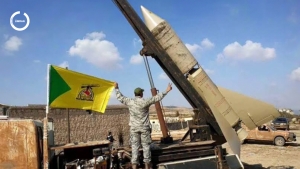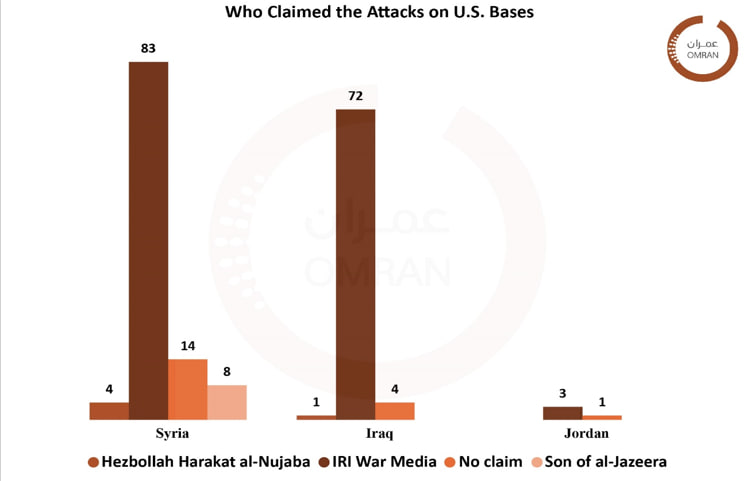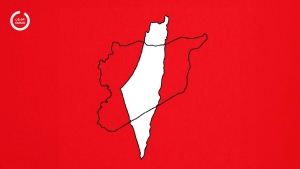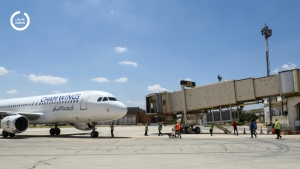Omran News
Analyzing Iranian-Orchestrated Attacks on U.S. Bases in Syria and Iraq Post Gaza War
Introduction
The landscape of Middle Eastern conflict underwent a notable evolution in the aftermath of the Gaza War, with the Islamic Resistance in Iraq (IRI) emerging as a significant player in the matrix of Iranian-backed military operations. This report scrutinizes the pattern of IRI-initiated strikes on U.S. installations in Syria and Iraq and evaluates the corresponding U.S. military responses within the framework of the broader geopolitical contest that unfolded post the Gaza War.
The data compiled within this document have been meticulously sourced from the following authoritative resources:
1. Official Statements and Bulletins: Data was sourced directly from the Islamic Resistance in Iraq's official Telegram channels, associated Popular Mobilization Units (PMU) factions, formal press releases from the United States, and attack chronologies developed by Dr. Hamid Hamed, a recognized expert on IRGC and PMU activities in the region(1).
2. Strikes Specifics: Detailed strike coordination’s were obtained by the author of the report using ArcGIS.
3. Report Visual: Map, Charts, Data Tables, were created by the author of the report using ArcGis, Power Pi, and Adobe Illustrator.
The Emergence of the Islamic Resistance in Iraq: Coordination and Operations
The term “Islamic Resistance in Iraq” first came to prominence following the 2003 U.S. invasion of Iraq, initially serving as an umbrella term for various Sunni armed factions known for their production of visual media and official statements. This collective identity waned as Shiite militant groups, backed by Iran, gained dominance. On October 21, 2023, the “Islamic Resistance in Iraq” reemerged in the spotlight when armed factions under this banner executed missile and drone strikes on U.S. military installations in Syria and Iraq. These attacks were a direct response to the Israeli offensive in the Gaza Strip in October 2023, which received U.S. support.
Unlike its initial formation in 2003, the reconstituted Islamic Resistance in Iraq, also referred to as Al-Muqawama al-Islamiyah fi al-Iraq, has evolved into a formidable coalition of militias with deep ties to Iran. Operating actively within Iraq and extending its influence into Syria, this alliance has become a pivotal force in the regional geopolitical arena. It challenges U.S. interests and presence through a sophisticated network of operations, employing military tactics to assert its influence and achieve its objectives across the Middle East(2). During the October 2023 conflict between Israel and Hamas, the Islamic Resistance in Iraq demonstrated its strategic capabilities and intentions by launching coordinated strikes against U.S.-aligned targets. These operations underscored the coalition's role as a significant actor in the broader regional conflict, capable of conducting complex military actions across borders. The group's involvement in these strikes aligns with Iran's regional goals and its commitment to countering U.S. military influence and policies in the Middle East.
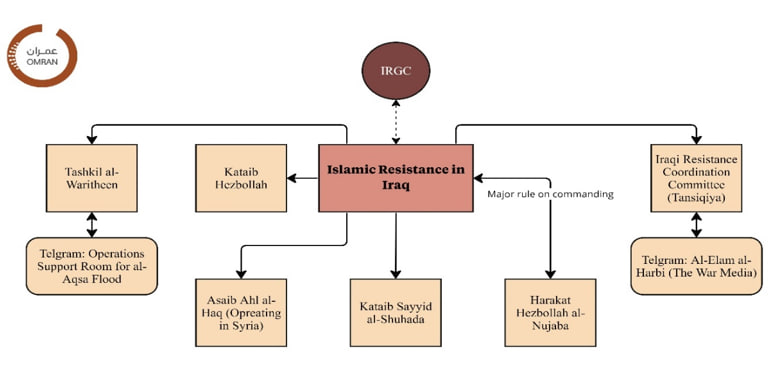
Figure (1): Islamic Resistance in Iraq Structure at the Time of Formation
The Islamic Resistance in Iraq's command structure showcases an advanced level of organization and coordination, significantly influenced by the Islamic Revolutionary Guard Corps-Qods Force (IRGC-QF), the IRGC-QF plays a crucial role in orchestrating the activities of the coalition, bringing together various Iraqi militia groups under a unified command for strategic purposes (3).
The strategic operations carried out by the coalition during this period were characterized by their high degree of coordination and sophistication, highlighting the group's ability to mobilize and execute military strategies effectively. These actions were not only aimed at challenging U.S. interests in the region but also demonstrated the coalition's capacity for significant military engagement. The ability of the coalition to extend its operations to Syria further exemplifies its broad reach and the transnational nature of its objectives.
The adoption of the “Islamic Resistance in Iraq” as a collective term is particularly noteworthy, echoing the nomenclature historically used by Iran-backed Iraqi armed groups. This branding strategy not only strengthens the collective identity of these militias but also acts as a unifying label that embodies their shared ethos of resistance. Prominent groups within the coalition, such as Kataib Hezbollah, Asaib Ahl al-Haq, and Kataib Sayyid al-Shuhada, have refrained from claiming separate operations within their usual areas of influence. This suggests a strong sense of unity within the coalition, emphasizing its role as a comprehensive representation of Iran-backed resistance efforts in Iraq (4).
Overview of Attacks Against U.S. Bases in Syria and Iraq by the IRI
Between October 18, 2023, and February 28, 2024, a total of /190/ attacks were reported against U.S. military bases in Syria and Iraq. The Islamic Resistance in Iraq (IRI) claimed responsibility for the majority of these incidents, showcasing a blend of conventional and innovative tactics in their operations. The group's arsenal featured medium-range missiles (al-Aqsa 1), drones (Qasef-2K/Shahed 101), and suicide drones, reflecting a strategic evolution and experimentation in their approach to combat. While the bulk of these assaults took place in Iraq and Syria, a handful were also recorded in Jordan, targeting vital strategic assets such as airbases, oil fields, and critical locations housing U.S. forces. These sites, heavily fortified with advanced defense mechanisms and artillery, underscore the strategic significance of the targets chosen by the IRI.
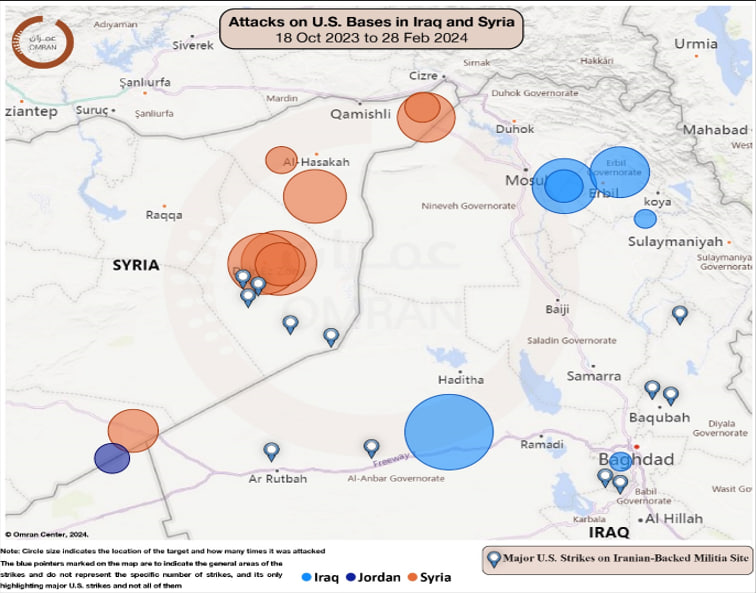
Map (1): Locations of the Attacks on U.S. Bases in Syria, Iraq, and Jordan – 18 Oct 2023 to 28 Feb 2024
Post-Gaza War Attacks on U.S. Bases
In the aftermath of the Gaza conflict, the IRI launched its initial assault on October 18, 2023, executing simultaneous strikes on the Ain Asad Airbase and the Harir US Base in Iraq. The Ain Asad Airbase emerged as a focal point, enduring /37/ documented attacks. The Harir US Base and Erbil Airport also ranked high on the IRI's target list, suffering /15/ and /5/ attacks, respectively. The IRI's tactics were marked by diversity and sophistication, employing Iranian-manufactured drones, artillery, and long-range missiles to execute their strategic objectives(5-6-7) Shifting focus to Syria, the al-Omar Oil Field and Conoco Gas Field were subjected to a combined total of /49/ attack. This strategic focus on targeting facilities near the border between the Syrian Democratic Forces (SDF) and areas controlled by the Syrian regime “Area of Iran high presence and influence” in Deir Ezzor highlights the IRI's strategic priorities. Military bases such as the Shadadi US Base and the al-Tanf US Base were also significantly targeted, receiving /17/ and /10/ attacks, respectively, further emphasizing the strategic pattern of the IRI's operations across the region. A detailed breakdown of the targets can be found in the Appendix.
This period of heightened activity by the IRI against U.S. bases in Syria and Iraq not only demonstrates the group's operational capabilities and strategic intent but also highlights the evolving landscape of military engagement in the region, with implications for both regional stability and international security dynamics.
| WK No. | Year | Start Date | End Date | Total Attacks by Week | %Attacks by Week | Total Attacks by Month | %Attacks by Month | Attacks in Syria | Attacks in Jordan | Attacks in Iraq |
| WK42 | 2023 | 18-10-23 | 24-10-23 | 13 | 7% | 28 | 15% | 4 | 1 | 8 |
| WK43 | 2023 | 25-10-23 | 31-10-23 | 15 | 8% | 10 | 0 | 5 | ||
| WK44 | 2023 | 01-11-23 | 07-11-23 | 20 | 11% | 51 | 27% | 14 | 0 | 6 |
| WK45 | 2023 | 08-11-23 | 14-11-23 | 15 | 8% | 11 | 0 | 4 | ||
| WK46 | 2023 | 15-11-23 | 21-11-23 | 9 | 5% | 3 | 0 | 6 | ||
| WK47 | 2023 | 22-11-23 | 28-11-23 | 7 | 4% | 2 | 0 | 5 | ||
| WK48 | 2023 | 29-11-23 | 05-12-23 | 4 | 2% | 48 | 24% | 2 | 0 | 2 |
| WK49 | 2023 | 06-12-23 | 12-12-23 | 16 | 9% | 9 | 0 | 7 | ||
| WK50 | 2023 | 13-12-23 | 19-12-23 | 9 | 5% | 7 | 1 | 1 | ||
| WK51 | 2023 | 20-12-23 | 26-12-23 | 4 | 2% | 2 | 0 | 2 | ||
| WK52 | 2023 | 27-12-23 | 02-01-24 | 15 | 8% | 8 | 0 | 7 | ||
| WK01 | 2024 | 03-01-24 | 09-01-24 | 10 | 5% | 47 | 26% | 7 | 1 | 2 |
| WK02 | 2024 | 10-01-24 | 16-01-24 | 12 | 6% | 6 | 0 | 6 | ||
| WK03 | 2024 | 17-01-24 | 23-01-24 | 8 | 4% | 4 | 0 | 4 | ||
| WK04 | 2024 | 24-01-24 | 30-01-24 | 17 | 9% | 8 | 1 | 8 | ||
| WK05 | 2024 | 31-01-24 | 05-02-24 | 4 | 2% | 16 | 8% | 2 | 0 | 2 |
| WK06 | 2024 | 06-02-24 | 12-02-24 | 6 | 3% | 6 | 0 | 0 | ||
| WK07 | 2024 | 13-02-24 | 19-02-24 | 3 | 2% | 3 | 0 | 0 | ||
| WK08 | 2024 | 20-02-24 | 28-02-24 | 3 | 2% | 0 | 0 | 0 | ||
| 190 | 109 | 4 | 77 | |||||||
| 57% | 2% | 41% |
Table (1): IRI Attacks Breakdown 18 October 2023 to 28 February 2024
Strategic Dynamics and Retaliatory Patterns in U.S.-IRI Conflict: A Timeline Analysis
Late October to Mid-November 2023: Retaliatory Dynamics in Deir Ezzor
The initiation of U.S. strikes on October 27, followed by further actions on October 30 and November 9, 2023, marks a period of increased military activity, notably during weeks 42 to 45. This escalation aligns with the visit of the U.S. Secretary of State on November 5, suggesting a deliberate pattern of engagement and possibly an effort to demonstrate U.S. determination. The temporal correlation between these U.S. military operations and the surge in attacks indicates a retaliatory dynamic, highlighting the conflict's reactive nature, where U.S. actions prompt immediate countermeasures by opposing factions.
December 2023 to January 2024: Escalation Following U.S. Airstrikes
A NOTICEABLE INCREASE IN ATTACKS IN WEEK 49 AND CONTINUING INTO EARLY JANUARY 2024 CORRELATES WITH U.S. AIRSTRIKES ON DECEMBER 23 AND SUBSEQUENT JANUARY OPERATIONS TARGETING NUJABA ATTACK CELLS AND THEIR LEADERS. THIS PATTERN SUGGESTS A CYCLE OF REPRISAL FOLLOWING U.S. MILITARY INTERVENTIONS. THE FLUCTUATING ATTACK RATES IN RESPONSE TO U.S. ACTIONS REVEAL A CONTINUOUS LOOP OF ACTION AND RETALIATION, EMPHASIZING THE DIFFICULTY OF SECURING A LASTING DE-ESCALATION THROUGH MILITARY MEANS ALONE.
Late January 2024: The Rukban (Tower 22) Attack and Its Aftermath
THE SIGNIFICANT UPTICK IN ATTACKS DURING WEEK 04, CULMINATING IN THE RUKBAN ATTACK ON JANUARY 28 THAT RESULTED IN SEVERAL U.S. CASUALTIES, FOLLOWED BY KATAIB HEZBOLLAH'S SUSPENSION OF ATTACKS ON JANUARY 30, REPRESENTS A CRITICAL JUNCTURE. THIS PAUSE IN HOSTILITIES MAY HAVE CONTRIBUTED TO A DECREASE IN ATTACKS AGAINST U.S. BASES, AS OBSERVED IN THE SUBSEQUENT REDUCTION IN WEEK 05. THIS SERIES OF EVENTS UNDERSCORES THE INTRICATE RELATIONSHIP BETWEEN DIRECT CONFRONTATIONS WITH CASUALTIES AND THE STRATEGIC DECISIONS BY MILITANT GROUPS TO TEMPORARILY CEASE OPERATIONS, EITHER FOR REASSESSMENT OR AS A TACTICAL PAUSE IN ANTICIPATION OF THE U.S. RESPONSE TO THE (TOWER 22) INCIDENT.
Early February 2024: U.S. Airstrikes and Strategic Implications
In early February 2024, the United States launched airstrikes on over /90/ locations in Syria and Iraq, targeting the operational capabilities of Iran-backed militias. Among the key figures targeted were two commanders from Harakat Hezbollah al-Nujaba, including the military operations director, Abu Baqr al-Saeedi. These actions are part of a broader U.S. strategy aimed at countering Iranian influence and militia activities in the Middle East, reflecting the intricate balance of military power, strategic interests, and regional dynamics. The U.S. justified these strikes as self-defense measures to protect its forces from Iranian-backed group attacks, emphasizing a focus on terrorist entities supported by the IRGC and avoiding Iraqi state forces to minimize collateral damage and prevent an escalation with Iraqi authorities.
Late February 2024: Strategic Pause by Militant Groups
A significant development occurred when Akram al-Kaabi, the General Secretary of al-Nujaba within the Popular Mobilization Forces and the Islamic Resistance in Iraq, announced a temporary cessation of hostilities against U.S. bases by his group and other IRI factions. This pause, described as a tactical repositioning rather than an end to hostilities, indicates a strategic recalibration by the militias in response to U.S. military pressure. This move suggests a nuanced interplay of tactics, signaling, and strategic adjustments by both U.S. forces and Iranian-backed groups, highlighting the ongoing complexity and unpredictability of the regional security landscape (8).
Pattern of the Attacks: IRI's Leading Role in Targeting U.S. Bases
Between October 18, 2023, and February 28, 2024, U.S. military bases located in Syria, Iraq, and Jordan were subjected to a total of /190/ attack. The IRI has been identified as the primary perpetrator, claiming responsibility for /158/ of these incidents. This represents approximately 83% of the total attacks, highlighting the IRI's dominant operational presence and its aggressive posture towards U.S. forces in the region. Additionally, Hezbollah al-Nujaba has acknowledged their role in /5/ specific events, which accounts for nearly 3% of the overall attacks. These targeted operations by Hezbollah al-Nujaba were reportedly in direct retaliation to U.S. strikes on their leadership and facilities.
The emergence of the “Son of Al-Jazeera” armed group, responsible for /8/ attacks or about 4% of the total during this period, marks a notable development. Although their involvement is relatively minor, these attacks were distinctly aimed at SDF personnel at U.S. bases or checkpoints within Deir Ezzor. Insights from sources in Deir Ezzor suggest that these incidents are linked to the ongoing tensions between Arab tribes and SDF/Asayish forces in the region. The volatile security environment, further destabilized by the IRI's actions, has led to several significant assaults, particularly near the Al-Omar oil field and Conoco gas field in Deir Ezzor, resulting in numerous SDF casualties.(9) However, /19/ incidents, accounting for 10% of the total, remain unclaimed. The absence of attribution for these attacks might reflect a strategic choice by certain groups to maintain operational secrecy or a deliberate decision to avoid recognition to prevent potential retaliatory or political consequences (10).
Chart (1): Analyzing Responsibility for Attacks on U.S. Bases - 18 October 2023 to 28 February 2024
Overall Implication and Strategic Assessment
The intricate geopolitical landscape of the Middle East, marked by the Islamic Resistance in Iraq's (IRI) calculated strikes on U.S. interests, showcases a nuanced Iranian strategy of employing proxy groups to extend its sphere of influence across the region. From October 2023 to January 2024, the IRI's assertive military operations have underscored its pivotal role within Iran's broader strategy of exerting pressure across the Middle East. This approach mirrors the tactics of other Iranian-backed militias in southern Syria against northern Israel, Hezbollah's activities in the same area, and the Houthi campaigns in Yemen and against Israeli targets. The synchronized efforts of these proxies, under Tehran's direction, represent a multifaceted campaign aimed at bolstering Iran's bargaining position against the United States. The uniformity of these operations across various fronts highlights a coherent Iranian strategy designed to project power and gain leverage(11).
In response, the United States has adopted a containment strategy aimed at mitigating IRI attacks and curbing broader Iranian influence, favoring management of regional tensions over escalation. This measured military response reflects a strategic choice to maintain the status quo while avoiding the onset of a larger conflict that neither the U.S. nor Iran desires. (12) The U.S. strategy extends beyond direct military engagements to include collaborative efforts with regional allies. From October 7, 2023, to March 5, 2024, Israel executed /41/ strikes on Iran-affiliated targets, significantly undermining their operational capabilities. These operations resulted in the destruction of several key locations and the assassination of /15/ high-ranking IRGC commanders, with the IRGC's War-Media unit confirming the deaths of /10/ of these figures. Moreover, Jordan's initiatives against armed groups in southern Syria, alongside joint UK-U.S. operations targeting the Houthis in Yemen, play a crucial role in the overarching U.S. strategy to counter Iranian influence in the region. These collaborative actions underscore a comprehensive approach to mitigating the challenges posed by Iran and its proxies, emphasizing the importance of international partnerships in addressing regional security concerns (13-14).
This multilateral approach underscores a concerted effort to challenge Iranian interests from multiple angles, thereby bolstering the effectiveness of U.S. containment strategies. Through both independent and coordinated actions, a comprehensive U.S.-led initiative aims to limit Iranian expansion without precipitating a wider conflict. In this complex environment, both Iran and the U.S. leverage their respective alliances and capabilities to exert influence and secure advantages, setting the stage for a potential return to diplomatic negotiations. Both nations, recognizing the risks of escalating a sustained pressure campaign into a more significant conflict, seem inclined towards dialogue. This strategic perspective acknowledges that while pressure tactics can be maintained temporarily, they do not serve the long-term interests of either party and pose the risk of sparking a broader confrontation that both sides are eager to avoid.
Conclusion
In summary, the activities of the Islamic Resistance in Iraq (IRI) from October 2023 to February 2024 mark a critical juncture in the geopolitical landscape of the Middle East, characterized by a nuanced blend of military actions, strategic positioning, and diplomatic efforts. The IRI's bold initiatives, including numerous attacks on U.S. interests and its synergy with Iran's regional goals, underscore its pivotal role in the complex geopolitical tapestry of the Middle East. These events not only pose challenges to the U.S.'s strategic interests in the region but also mirror the larger power struggle between the U.S. and Iran, a contest played out through proxy groups and tactical military engagements.
The IRI's advanced organizational structure, strategic operations, and unified branding as a resistance movement reflect a deliberate strategy of military and political engagement. This strategy is emblematic of Iran's broader aim to utilize proxy forces as tools of regional dominance, seeking to assert influence and gain strategic advantages over the United States. The sequence of assaults followed by U.S. and allied counteractions highlights a persistent cycle of action and reaction, emphasizing the difficulties in securing enduring peace and stability in the region solely through military means.
This era of heightened conflict and strategic interaction between the IRI, the U.S., and their allies accentuates the need for a comprehensive approach that goes beyond conventional military responses. Such an approach must integrate diplomatic initiatives, political solutions, and regional collaborations to adeptly address the multifaceted challenges facing the Middle East. The primary objective should be to de-escalate tensions, avert a wider conflict, and strive for a lasting peace that tackles the root causes of the ongoing cycle of violence and retribution. The events spanning late 2023 to early 2024 serve as a vivid reminder of the delicate power equilibrium in the region and the paramount importance of strategic diplomacy in reducing the risk of further escalations and ensuring long-term stability.
([1]) Islamic Resistance in Iraq and other affiliations accounts on Telegram Platform. (To better understand how the present any positive/negative developments for their followers)
([2]) The Islamic Resistance in Iraq...a coalition of armed groups to support the “Al-Aqsa Flood”, 5 February 2024. Al-Jazzera https://shorturl.at/gmqL8
([3]) The Islamic Resistance in Iraq, October 17, 2023. Hamdi Malik, Michael Knights, https://bit.ly/3wFASrj.
([4]) Profile: Al-Warithuun, September 13, 2022 (Updated on October 2023), The Washington Institute, Michael Knights, Hamdi Malik, Crispin Smith, https://bit.ly/3P5obfV.
([5]) Signs of Iranian Coordination in Iraqi Base Attacks and Messaging, The Washington Institute, Post October 17, 2023. Analyzes the coordination behind attacks on US bases in Iraq, emphasizing Iranian involvement.
([6]) The "Islamic Resistance" in Iraq: We attacked 3 American bases in Iraq and Syria with missiles and drones, 24 February 2024 https://shorturl.at/txDMY
([7])Syria & Yemen, The Iran Primer, United States Institute of Peace, October 18, 2023. Insights into drone and rocket attacks by Pro-Iranian militias in Iraq and Syria.
([8]) A movement affiliated with the “Iraqi Resistance”: We continue to target Zionist sites, February 25, 2024, Al-Quds https://shorturl.at/nKX14
([9]) Anti-U.S. Attacks Linked to the Sons of Jazira and Euphrates Movement, The Washington Institute, October 27, 2023. Hamdi Malik, Michael Knights https://bit.ly/3P7xoEt.
([10]) Iran Update, October 23, 2023, Institute for the Study of War, October 23, 2023. Discusses Iranian activities and positions in relation to the ongoing conflict.
Iran Update, October 24, 2023, Institute for the Study of War, October 24, 2023. Analysis of Iran's information operations and their i
mpact on the conflict.
Iran Update, November 18, 2023, Institute for the Study of War, November 18, 2023. Briefs on recent threats and attacks by Iranian-backed militias against US forces.
([11]) “The calm before the storm and surprises are coming.” Al-Nujaba escalates its rhetoric against the American forces in Iraq, 26 February 2024. Sputnik https://shorturl.at/xLVY6
([12]) Assessment of Security Threats to U.S. Military Installations in the Middle East Post-Gaza Conflict, U.S. Department of Defense, https://www.defense.gov
([13]) U.S. launches strikes in Iraq, Syria, nearly 40 reported killed, February 04, 2024. Reuters https://bit.ly/3wE3v8d
([14]) US Strikes Stoking Tensions with Iraq, February 06, 2024. Jeff Seldin, Voice Of America, https://bit.ly/49AcqGq.
Gaza War: The Responses of Syria’s Local Actors
Given Syria's involvement in the Arab-Israeli conflict since 1948, solidarity with Palestine has been a fundamental element within Syria's political culture. Regarding Syria's local actors’ stances on Gaza war (Syrian regime, Syrian opposition, “Hayat Tahrir al-Sham”, and “Syrian Democratic Forces”), while there is consensus in expressing solidarity with the Palestinian people in Gaza, their approaches to the war varied significantly in respective to their stances on Hamas, the “al-Aqsa flood” operation, and how they used the war in their different political strategies. These differences stemmed from a blend of ideological political identities on one hand and objective considerations related to their different relations with international and regional actors on the other. This article provides insight into the discourse projected by these actors on Gaza.
The Syrian regime has consistently propagated a narrative of resistance since the onset of the Gaza war, publishing official statements through its foreign ministry or speeches delivered by its prominent figures, notably Bashar al-Assad and his Foreign Minister, Faisal Mekdad. The regime praised the “al-Aqsa flood” operation as a “glorious achievement,” linking it to the October 1973 war due to its historical significance as a victory within the Syrian and Arab narrative.
Using the Gaza war in emotional mobilization of its popular incubator and its narrative of conspiracy, the regime associated the Israeli aggression with the ongoing struggle in Syria, holding Israel accountable for supporting the perpetrators of the drone attack on the Homs Military Academy on October 5th. This sentiment was further underscored by Mekdad when he criticized the stances of the United States and European states on Gaza accusing them of “Western deceit and open appetite for killing Arabs, including Palestinians.” In response to Israeli escalation of targeting various Iranian and regime sites in Syria, the regime continued to propagate a discourse centered on the right to defend sovereignty and reclaiming the Golan Heights within the 1967 borders.
By political means, the Syrian regime leveraged the regional atmosphere after the Gaza war to bolster its diplomatic activity within the Arab League and its bilateral diplomatic engagement with various Arab countries. While Assad advocated for halting the process of Arab-Israeli normalization during the extraordinary joint Arab Islamic summit on Gaza in November, the regime did not record formal reservation on any of the summit's resolution provisions, including having “normal relations with Israel,” a reservation upheld by Algeria, Iraq, and Tunisia (1).
This reflects the regime's alignment with the official and prominent Arab stance concerning the Israeli aggression on Gaza in formal diplomatic means, while concurrently maintaining a vehement anti-Israeli and anti-Western sentiment through its rhetoric, as a cornerstone of the “axis of resistance” led by Iran.
“Hayat Tahrir al-Sham” adopted a different narrative toward the “al-Aqsa flood” operation in comparison to jihadist groups - al-Qaeda and its branches - that advocated in their statements for jihad and targeting Western sites in Muslim countries. HTS's official rhetoric, expressed through statements by its “Syrian Salvation Government,” revolved around praising the operation carried out by Hamas, endorsing the Palestinian people's right of “the entire liberation of Palestinian land,” and calling on the “international community and Arab nations” to halt the Israeli aggression on Gaza after the Israeli targeting of Jabalia refugee camp. HTS’s call, in essence, mirrored a statement issued earlier by the Taliban government, which has been promoted as a “model” by prominent figures within HTS.
As it has been promoting itself as a moderate actor, the SSG’s Ministry of Media issued -ironically- a statement on press freedom and condemned the Israeli targeting of journalists regardless of their faith. This condemnation included Israeli violations of the targeting of journalist Wael al-Dahouh's family, the killing of journalist Sherin Abu Akel in Palestine, and the targeting of journalist Carmen Joukhadar in Lebanon.
At the same time, the jihadist element remained present in the speeches of HTS figures, notably Abdul Rahim Atoun, the head of its Fatwa Council. He said that the conflicts in both Syria and Palestine constitute a jihad that is an "obligation" upon every Muslim. This declaration was made during a symposium titled "From Idlib to Gaza... One Wound," organized by the SSG’s Ministry of Media. This highlights the tone difference in the technical statements and media discourses as well as the continuation of the jihadist ideological element within HTS's narrative.
Nevertheless, the primary objective of the symposium was to draw parallels between the Palestinian resistance against Israel and the Syrian struggle against the regime. The focus was on highlighting the similarities in crimes committed against the Syrian and Palestinian people, by the Assad regime and Israel respectively. This narrative resonated with SSG’s official statement, which regarded Palestinian resistance as an inspiring model for the struggle against the Syrian regime. A narrative aligns with HTS's efforts to project a national-Islamist image at the expense of its former Jihadist one.
As for the Syrian Opposition, the Syrian Negotiation Commission, the Syrian National Coalition, and the Syrian Interim Government expressed solidarity with Gaza, particularly following the bombing of al-Maamadani Hospital. Both the statements from the Negotiations Committee and the National Coalition condemned the crimes committed by Israel and emphasized the significance of the Arab Peace Initiative (2002), rejecting the forced displacement of Gaza residents. Simultaneously, the Interim Government condemned the crimes of the Israeli occupation and declared a three-day national mourning in its controlled areas.
Regarding their stance on Hamas or “al-Aqsa flood,” there hasn’t been any official statement or position issued on the matters, given the challenge of attaining a unified stance within the opposition due to the varying and sometimes conflicting positions toward Hamas, driven by ideological or political reasons related to Hamas's stance on the Syrian regime or Iran. Let alone the objective considerations related to the opposition’s political relations with international and regional actors.
As for the “Syrian Democratic Forces,” the SDF-affiliated “Syrian Democratic Council,” issued a statement condemning the targeting of civilians in Gaza, particularly the al-Maamadani Hospital, taking into consideration the pro-Palestinian sentiment among Syrians. The statement made reference to the “right of the Palestinian people to self-determination,” in line with SDF’s claim of the “Autonomous Administration” in Northeastern Syria. On Hamas, the head of the SDF, Mazlum Kobane, condemned it, yet expressed concerns over the Israeli objective to eradicate Hamas because of the potential spillover effects of such eradication.
The response of local actors in Syria to the Gaza conflict varied significantly in their level of engagement, political stances, and the use of the war in their narratives. There has been notable and active engagement by the regime and HTS, moderate engagement from the opposition, and cautious one from the SDF. The regime leveraged the Gaza war in emotional mobilization within its popular incubator as a cornerstone of the resistance axis by endorsing Hamas. Simultaneously, the regime has politically capitalized on the regional atmosphere to strengthen its diplomatic presence within Arab politics. HTS has also used the war in emotional mobilization in Idlib and in its rebranding process as a local actor endorsing Hamas as a model. In contrast, the opposition limited its response to humanitarian solidarity with Gaza, refraining from issuing an official stance on Hamas. The SDF pursued minimal engagement with Gaza and was the only actor to take an anti-Hamas stance along with fearing the repercussions of the war.
Finally, the result of the war on Gaza, will have impact on these actors, particularly for HTS and SDF, at least in terms of boosting their confidence to survive as semi-state actors in case Hamas survives the Israeli military campaign or diminishing that confidence in case Israel manage to eradicate Hamas.
([1]) This stance followed the regime's prior formal reservation on “any wording that could be interpreted to equalize between the Israeli occupier and the Palestinian people living under occupation,” in the resolution of the extraordinary ministerial session of the Arab League on Gaza in October, akin to reservations expressed by Iraq, Libya, Algeria, as well as Tunisia which objected to the resolution entirely, advocating for “the right of the Palestinian people to establish their independent state on all of the territory of Palestine.”
Monthly Briefing on the Events of the Syrian Scene October 2023
General Summary
This report provides an overview of the key events in Syria during the month of October 2023, focusing on political, security, and economic developments. It examines the developments at different levels.
- Politically, the political scene in Syria was affected by the Israeli aggression on Gaza, and the residents of as-Suwayda continued their weekly demonstration on Fridays, demanding political transition and reforms.
- Militarily, A drone strike hit Homs' military college, killing /123/, as reported by regime media. In retaliation, the regime bombed Idlib and Aleppo's outskirts. Concurrently, Turkey launched airstrikes on Syrian Democratic Forces “SDF” leaders following a PKK-claimed September attack in Ankara. Amidst Israeli strikes on Gaza, US bases in Eastern Syria saw over /18/ Iranian-backed militia attacks, with Israel also targeting Syrian airports in Aleppo and Damascus.
- Economically, Syria's regime revealed a 2024 budget 114% higher than the last, signaling ongoing deficit spending and rising poverty. Moves to float the Syrian pound and cut private sector support were marked by currency devaluation and updated bi-weekly fuel prices.
The Israeli-Gaza Conflict Impacts on Syria and the Homs Military Academy Explosion's Aftermath
In the Regime Held-Areas
The escalating tensions in Gaza have markedly impacted regional dynamics, prompting:
- Over /30/ attacks by Iranian-backed militias on US bases across Syria and Iraq.
- 2Increase in Israeli airstrikes targeting Syrian Regime facilities.
Key sites such as the US's al-Tanf base, al-Omar oil field, and the al-Shadadi base have been subjected to intensified UAV and rocket attacks by these militias. Additionally, the Koniko gas pipeline, the American base in “Rubarba” near al-Malikiyah, and the “Kharab” base have sustained damage from these attacks.
Beginning October 7th, Israel escalated its military actions against Syrian Regime and Iranian-backed militia targets, executing over nine strikes in different areas. Significantly, Israel targeted Aleppo International Airport four times, Damascus International Airport twice, and four military locations in Daraa. These strikes in October represent a strategic shift, aiming to:
- Preventing Iranian Influence: Israel's efforts to prevent Iranian militias from strengthening their positions in Southern Syria, especially following the events in Gaza, suggest a proactive approach to counter what it perceives as a growing Iranian influence in the region. This is in line with Israel's long-standing policy of countering Iranian expansion and influence in neighboring countries.
- Demonstrating Military Readiness and Capability: The nature of these strikes, notably their scope and precision, serves as a demonstration of Israel's military readiness and capability to operate on various fronts. This could be intended as a deterrent to potential aggressors and a show of strength to both regional and international audiences.
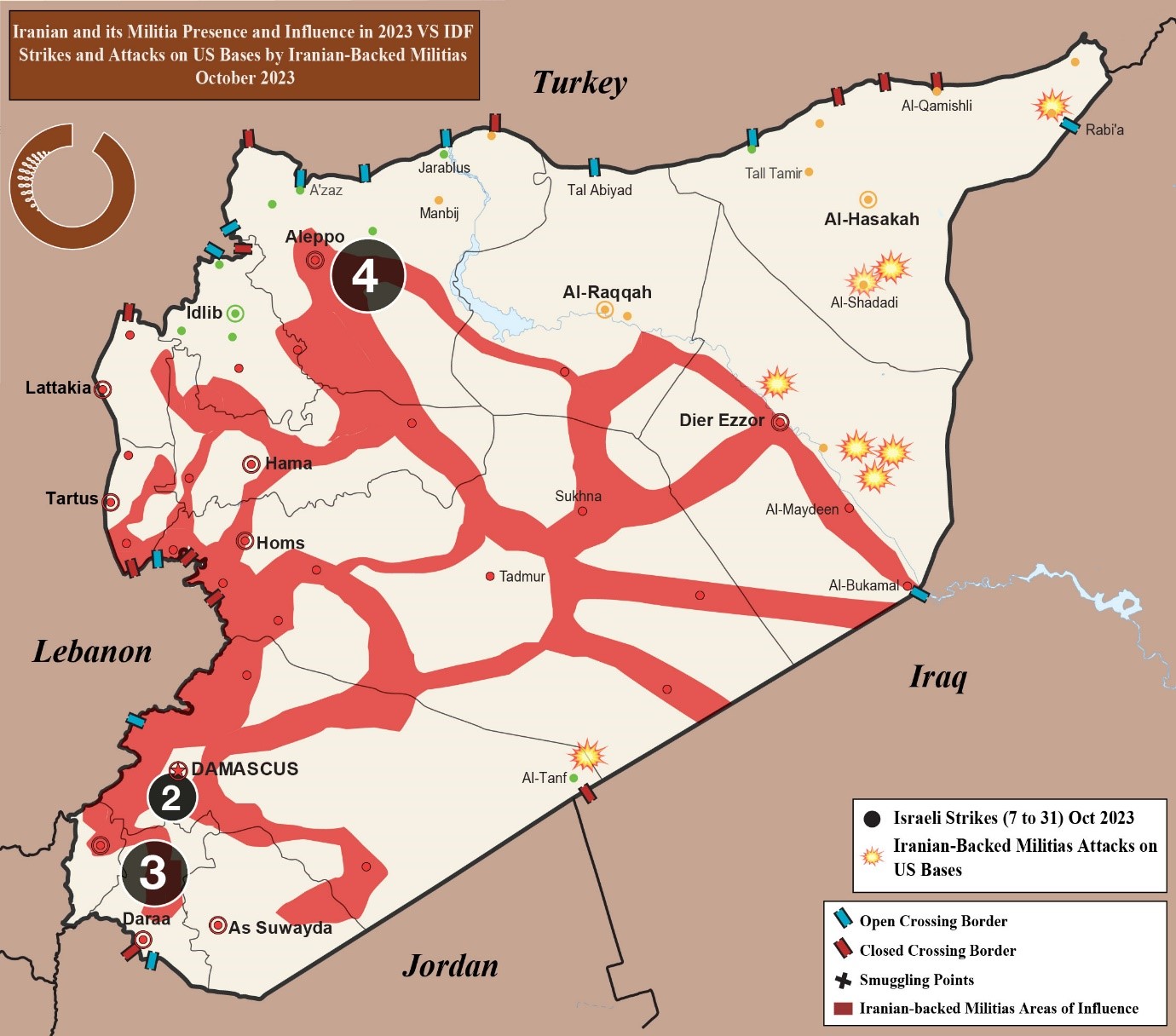
In another development, the military college in Homs city was attacked by unidentified drones, according to regime media, resulting in the deaths of dozens, including officers. This attack is notable for several reasons:
- Ten officers were killed, including two with the rank of brigadier.
- The human toll was significant, with /123/ people killed.
- This attack is viewed as a major security breach, as it targeted a location known for its high level of security.
The attack on the military college led the regime, with Russian support, to launch airstrikes and heavy artillery bombardments on over /30/ locations in Northwest Syria, blaming what they labeled as “Terrorist Organizations” for the attack. This resulted in the deaths and injuries of dozens, including /14/ children, /12/ women, and /38/ men.The regime aimed to use this incident to:
- Strengthen its narrative against revolutionary forces and the opposition.
- Advance its military position on the ground.
- Disrupt the stagnant political process.
- Gain sympathy from Arab and foreign countries to support the regime and condemn the attackers.
- Distract Arab countries from their initiative demanding concessions from the regime on various issues.
In the SDF Held-Areas
Following the “PKK's” claim of responsibility for the Ankara attack near the Turkish Ministry of Interior on the 1st of October 2023, the Turkish Armed Forces launched a series of airstrikes and security operations targeting “SDF”, military bases, and vital facilities in northeast Syria, the technical aspect of this operation signifies a shift in the Turkish military strategy and goals:
- Expanding the geographical scope of targets to locations about 70 km from the Turkish border.
- Targeting infrastructure like oil facilities and electricity generation and distribution stations.
- Striking weapon depots, training camps, and buildings of civil institutions affiliated with the Autonomous Administration.
- Targeting leaders and members of the “Asayish” internal security forces.
- Set new conflict and engagement rules and pressure the US to reconsider its alliance with the SDF in northeast Syria, considering Turkey's security concerns.
Echoes of Gaza in Syria, Civil Unrest in As-Suwayda, and Deir Ezzor's Quest for Calm
The Israeli aggression on Gaza affected the political environment in the region and had a direct impact on the Syrian file. During a UN Security Council session, U.S. Ambassador “Linda Thomas-Greenfield” noted that the events in Gaza are:
- Extension of Iran's security and military increasing role and Hezbollah's militia in Syria.
- Resolving the Gaza and Syria situations starts with stopping the expansion of these militias.
Syrian National Coalition “SNC”
The French FM “Catherine Colonna” canceled a meeting with the “SNC” delegation, which had traveled to Paris to urge French officials to hold a Security Council session and take necessary actions to stop the Regime military escalation in Northwest Syria.
The “SNC” met with Turkish FM “Hakan Fidan”, focusing primarily on economic demands and the need to empower the Syrian Interim Government to provide basic services to the people.
Syrian Regime
The Saudi FM contacted the Syrian regime's FM to discuss regional developments and bilateral relations. “Bashar al-Assad” also met with the Iranian FM in Damascus to discuss the Israeli aggression on Gaza. The regime appointed an ambassador to Tunisia, aiming to enhance its effectiveness in regional and international forums.
In the Southern region, at As-Suwayda Governorate:
- Civilians continued to protest against the regime's indifferent approach and its refusal to make concessions, despite being unable to provide services and funds to the province.
- The Ministry of Local Administration offered a (Gant) of /300/ million SYP, equivalent to about /24,000/ USD.
- Tribes in Daraa and as-Suwayda formed a unified council to unite the efforts of the tribes in both governorates, enhance communication, resolve disputes, and prevent external attempts to create a similar council.
Syrian Democratic Forces
The Autonomous Administration in Northeast Syria and the Deir Ezzor Civil Council held a conference to involve the people of Deir Ezzor in decision-making and address public discontent in the governorate. The conference included various community segments, administration employees, and local leaders from Deir Ezzor. The conference concluded with recommendations to:
- Enable real participation of the locals.
- Build a robust administrative structure based on genuine competencies.
- Strengthen the military security force.
Economic Crisis Deepens: Struggling Against Corruption and Insignificant Reforms
In the Regime Held-Areas
The Supreme Council for Economic and Social Planning has set the 2024 budget for Syria at /35,500/ billion SYP. This is 114% more than last year but 27% less than in 2022 when converted to USD. This budget is unlikely to help the economy grow and will probably cause more inflation and reduce the value of the Syrian lira.
The Central Bank has set the official exchange rate of the Syrian lira to the USD at /12,500/ SYP, close to the black-market rate /13,900/ SYP. Since the start of the year, the Central Bank was and still trying to close the gap between the official and the black-market rates, to encourage people to use the official rate to help increase foreign currency reserves.
Despite the rising cost of living, the Regime government kept on exporting a lot of vegetables and fruits, mainly to Saudi Arabia. This has led to higher prices locally because of reduced supply and increased costs for things like fuel, seeds, transport, and labor. This approach shows a lack of concern for the citizens' living standards and seems to favor the interests of businesspeople and profit over everything else.
In the SDF Held-Areas
Attempts by the administration to regulate the markets and money movements have met with objections from traders. After the Autonomous Administration issued a circular reminding of the necessity to obtain the necessary licenses to engage in currency exchange and financial remittances, set minimum capital clauses, and deposit money with the Monetary Office
The Corruption in within the Autonomous Administration continues to undermine the development of the region and puts pressure on the livelihood of the population, notable incidents:
- Dozens of farmers have complained about not receiving their dues for the crops supplied about 3 months ago.
- Administration employees have complained about delayed salaries due to the alleged lack of budget amidst the difficult economic conditions experienced by the residents of the region in general.
- Teachers complained about having to pay more than 30% of their salary to pay for electricity (amperes), water, and the internet.
- The wages for farming have risen from /7,000/ SYP to /28,000/ SYP per dunum, excluding other expenses, turning agricultural activity into a losing process. This leads to farmers abandoning their agricultural lands.
- RCELL company increased the prices of internet packages by about 400%. The company enjoys broad support from the “Autonomous Administration”.
In the Opposition Held-Areas
Idlib witnessed the opening of its first textile factory, this development might inspire other entrepreneurs to establish similar factories in the area. Additionally, the city hosted the (Idlib Markets 2023) exhibition, featuring numerous new companies and stores. This event is significant for several reasons:
- It allows direct sales to consumers, making essential items more affordable for locals.
- It fosters healthy competition among businesses, leading to discounts ranging from 30% to 40%.
In North Aleppo, the Syrian-Turkish Electricity Company has reduced electricity rates to /2.77/ TL for residential use and /3.17/ TL for industrial and commercial use in Jarablus, Afrin, Azaz, and surrounding regions.
Efforts to revive the economy continue, with local councils and organizations collaborating on infrastructure projects like road repairs, water, and sewage pipe installations, and extending electricity networks. To regulate local affairs, several directives have been issued:
- Health organizations in Jarablus must get official approval before announcing job openings on social media.
- Private educational institutions must secure licenses from the Directorate of Education.
However, the agricultural sector in Ras al-Ain is experiencing difficulties. The interim government is grappling with several issues:
- Preventing large local traders from pressuring cotton farmers into selling their crops at prices that are too low to cover the costs of production, resulting in financial losses.
- The challenge of stabilizing cotton prices, which currently vary between /500/ and /550/ USD per ton, a significant drop from the previous year's range of /750/ to /800/ USD.
- The issue of low wages for agricultural workers, which remain capped at a maximum of two dollars per day.

